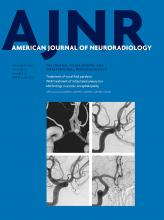We appreciate the interest in our article and comments made by Dr Gao et al. We agree that prediction of clinical outcomes in patients with posterior reversible encephalopathy syndrome (PRES) is a challenging subject. Dr Gao et al raised interesting points in their letter regarding both measures of MR imaging severity and clinical outcomes.
First, while clinical outcomes were addressed in the study, the study in question focused primarily on the presence of enhancement in PRES and whether it was associated with any of the measured clinical factors. Because no such associations were found, we suggested that gadolinium-based contrast may not be necessary in diagnosing or assessing the degree of severity of PRES.1 As noted, however, our results did show a significant association between clinical outcomes and the extent of the T2 signal abnormalities used to grade the radiologic severity.
Dr Gao et al suggested that regions of cytotoxic edema in PRES (visible on DWI) are frequently associated with larger areas of vasogenic edema. This observation may be in agreement with a hypothesis regarding the pathophysiology of restricted diffusion in PRES, in which endothelial dysfunction and vasogenic edema and ensuing potential compression of local microcirculation or vasospasm lead to resultant ischemia or infarction.2⇓–4 Previous studies have shown that this phenomenon occurs in a minority of patients with PRES and that such areas of reduced diffusion (ie, cytotoxic edema, low ADC values) typically occur within larger areas of elevated diffusion (ie, vasogenic edema, high ADC values) and may assume a punctate or gyriform pattern.2,5 Better evidence is needed to determine whether the presence of cytotoxic edema correlates with clinical outcome. We also opine that the presence of hemorrhage, ranging from frank parenchymal (in up to 20%) to microhemorrhage (in >50%), needs to be further assessed with regard to its effect on outcome.2,6
In regard to the different scales used to predict outcome, we believe that our outcome score scale is not entirely dissimilar to the modified Rankin Scale, reflecting the degree of residual neurologic disability in patients with stroke, or from the Glasgow Outcome Score (GOS), useful for global assessment following brain injury. The GOS has been used by Legriel et al7 to determine outcomes of severe PRES 90 days after the presentation. Future studies could evaluate whether any of these clinical scales best reflect eventual outcome and ultimately whether MR imaging severity or any of the MR imaging findings at initial presentation correlate with outcome.
References
- © 2016 by American Journal of Neuroradiology












